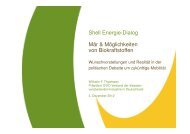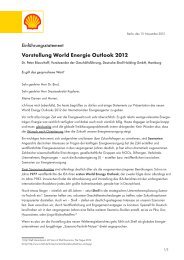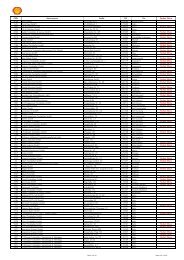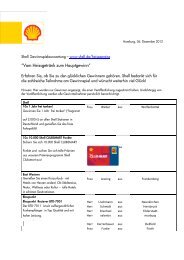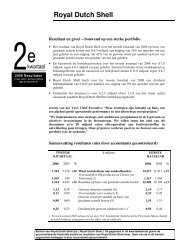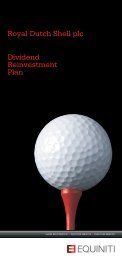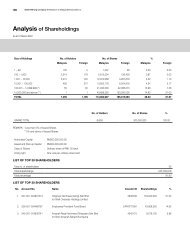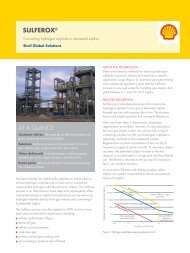62414 sustain 40pp (Mag)
62414 sustain 40pp (Mag)
62414 sustain 40pp (Mag)
You also want an ePaper? Increase the reach of your titles
YUMPU automatically turns print PDFs into web optimized ePapers that Google loves.
Alternative energy<br />
Interest in alternatives to fossil fuels is<br />
growing fast as concerns over climate<br />
change and energy security rise. Our aim is<br />
to have a substantial commercial business in<br />
at least one alternative energy technology.<br />
We are focusing on the most promising<br />
technologies – advanced biofuels and hydrogen<br />
for transport, and wind and thin-film solar for<br />
electricity – and working hard to lower their costs<br />
so they can compete effectively with fossil fuels.<br />
Transport options<br />
Transport biofuels are typically more expensive<br />
than petrol or diesel. However, they reduce<br />
dependence on oil and, because the plants<br />
absorb CO2 as they grow, they can also have<br />
lower overall carbon emissions, despite the<br />
extra energy required to harvest and process<br />
them. A number of governments are giving<br />
biofuels a big push with subsidies, targets and<br />
mandates. For their efforts to succeed more<br />
technologically advanced biofuels, based on<br />
agricultural waste, will be needed.<br />
Today’s first-generation biofuels may compete<br />
with food crops for land. The CO2 reductions<br />
they achieve are sometimes limited. We are<br />
helping tackle this by continuing to invest in<br />
second-generation biofuels, for example through<br />
our partnerships with Choren and Iogen (see<br />
box) and by developing codes of conduct for<br />
the <strong>sustain</strong>able sourcing of biofuels (page 18).<br />
Hydrogen is a longer-term option. It is a new<br />
type of fuel that would require additional<br />
infrastructure to distribute it and modified<br />
engines to use it. That would take time and<br />
require substantial investment. We were the<br />
first energy company to build demonstration<br />
hydrogen filling stations in Asia, Europe and<br />
the USA. Shell Hydrogen is also working on<br />
“mini-networks”, where hydrogen is offered<br />
at a number of regular fuelling stations, so<br />
that hydrogen vehicles can operate freely and<br />
refuel throughout a city.<br />
Sources of electricity<br />
Shell Wind is a major wind power developer,<br />
with stakes in projects generating 850 megawatts<br />
of electricity (415 MW Shell share). It plans to<br />
expand its portfolio to nearly 1,000 MW (500<br />
MW Shell share) by the end of 2007. That is<br />
enough electricity for more than half a million<br />
homes. In Europe, we are developing projects at<br />
sea where, despite higher costs and difficulties<br />
connecting to onshore transmissions grids, winds<br />
are stronger, larger turbines can be used and there<br />
is less visual disturbance. In 2006, the Noordzee<br />
Wind offshore wind farm started production<br />
(see box) and the 1,000 MW London Array<br />
project, which we are partners in, received<br />
offshore planning permission. Consent to build<br />
the onshore connection depends on the result of<br />
a local public inquiry. London Array would be<br />
the world’s largest wind farm and is being actively<br />
supported by the Royal Society for the<br />
Preservation of Birds and the World Wildlife<br />
Fund. In 2006, construction began on the Mount<br />
Storm project (164 MW, 50% Shell share) in<br />
West Virginia, USA and efforts continued to<br />
develop wind power projects in China.<br />
Like the current wave of venture capitalists<br />
investing in solar, we believe thin-film technologies<br />
show the most promise for driving down the<br />
costs of turning sunlight into electricity. In 2006,<br />
we successfully completed our joint venture<br />
agreement with glassmaker Saint-Gobain to<br />
develop next generation Copper Indium<br />
Diselenide (CIS) thin-film technology. CIS uses<br />
100 times less raw material than today’s silicon<br />
crystalline modules. It is easier and, we expect,<br />
cheaper to produce in high volumes. The joint<br />
venture – AVANCIS GmbH – began<br />
construction of a 20 MW panel manufacturing<br />
plant in Germany in November 2006.<br />
Additional web content:<br />
• Our efforts to build competitive wind, solar and<br />
hydrogen businesses.<br />
• The approach we are taking to responsible biofuels.<br />
• Investing in second generation biofuels (Choren GmbH<br />
and Iogen).<br />
www.shell.com/alternativeenergy<br />
IOGEN: TURNING STRAW INTO FUEL<br />
The challenge now for biofuels is to make<br />
them cheaper, reduce the CO2 emitted<br />
during their production and use sources<br />
that do not compete for land with food<br />
production. That is why we have invested<br />
in Iogen Corporation, whose patented<br />
technology uses enzymes to produce ethanol<br />
from straw. The resulting “cellulose ethanol”<br />
is a fuel with 90% lower GHG emissions<br />
than conventional petrol on a lifecycle basis<br />
and no need for extra arable land. Iogen’s<br />
NOORDZEE WIND: ON TIME AND<br />
ON BUDGET<br />
In October 2006, households in the Netherlands<br />
began receiving clean electricity from the<br />
Egmond aan Zee Offshore Wind Farm in the<br />
North Sea. Developed by Shell Wind Energy<br />
and power company Nuon, the 108 MW<br />
wind farm supplies enough carbon-free<br />
power for more than 100,000 Dutch homes,<br />
saving around 140,000 tonnes of CO2<br />
emissions a year.<br />
Our offshore oil and gas experience helped<br />
overcome the technical challenges and deliver<br />
the project on time and on budget. The focus<br />
now is on improving the operational<br />
performance of offshore wind by reducing<br />
maintenance costs and increasing the amount<br />
of time that turbines are available to produce<br />
power. Generating wind power offshore is<br />
currently about twice as expensive as onshore,<br />
so government support remains critical to<br />
making it a viable alternative to conventional<br />
power generation.<br />
demonstration plant has been producing fuel<br />
from straw since 2004. Iogen’s ethanol has the<br />
potential to be cheaper to produce than most<br />
of today’s biofuels. In 2006, Goldman Sachs –<br />
the investment bank – invested in Iogen. In<br />
early 2007, Iogen was one of six companies<br />
selected to receive funding under the USA<br />
Department of Energy’s $385 million cellulose<br />
ethanol programme – a further vote of<br />
confidence in the commercial potential of<br />
this exciting technology.<br />
THE SHELL SUSTAINABILITY REPORT 2006 15



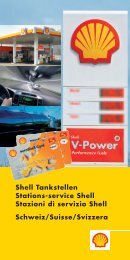
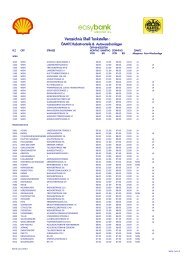
![Download Shell AutoGas Stationen [Stand: Januar 2013] (PDF](https://img.yumpu.com/9982753/1/190x245/download-shell-autogas-stationen-stand-januar-2013-pdf.jpg?quality=85)
